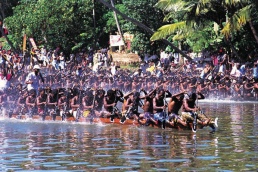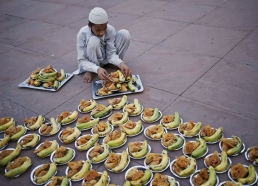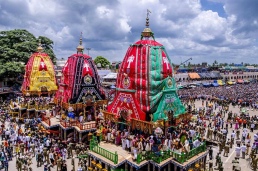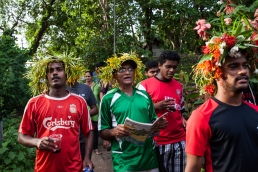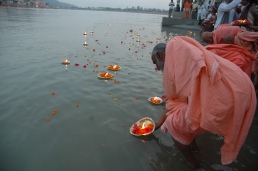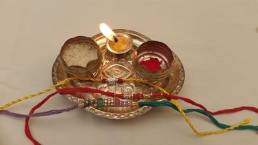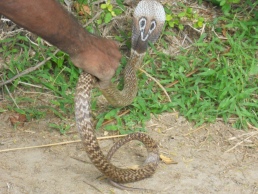Champakulam Boat Race
Champakulam Boat Race
The first in the season of snake-boat races (Vallam Kali) in the State, the Champakulam “Moolam” Boat Race is a tradition that is more than 500 years old and is held on the Pampa river at Champakkulam. The race is organized by the Champakulam boat race society and headed by the district collector. Different categories of boats are used in this race. Some of the most well known categories are the chundan (snake boat), which is the most decorated and attention grabbing. The veppu, iruttu kuthi, churulan and Odi are a few others.
Legend has it that during 1545 A.D., Maharaja Devanarayana of Chempakasseri built a temple for Lord Krishna at Ambalapuzha as per the suggestions of his astrologers. But at the last moment, the deity meant for the temple was found to be inauspicious. The priests therefore identified another idol of Lord Krishna at the Karinkulam temple at Kurichi. This idol was believed to have been given to Arjuna by Lord Krishna himself. On the way back from Kurichi, night had set in and the King’s men stayed at a Christian household in Champakulam. This was the home of Mappilassery Itty Thommen, a loyal subject and a confidant of the king. The next day, the king along with his entourage came to Champakulam and respectfully took the idol in a flotilla to the Ambalapuzha temple.
Pleased with the love and affection shown by the Christian subjects and to commemorate the event and to strengthen the ties of the Hindu-Christian community, the King declared that henceforth a water festival would be held annually at Champakulam and thus began the Champakulam Snake Boat Race which continues even today.
On the day of the race, both the locals and visitors from far off places, flock to the river bank to enjoy the scenes of the race. This race is often considered as the ultimate test of endurance, speed and skill. As the oarsmen set the pace of their boats with oars striking the placid water, the river becomes a track on fire and becomes a real feast for the eyes and minds of the spectators.
Ramzan (Eid al-Fitr)
Ramzan (Eid al-Fitr)
The festival of Ramzan is not a one day celebration. The eve of Ramzan marks the end of a month long dawn-to-dusk fasting (the month of Ramzan) by the Muslims that is marked with alot of excitement and rejoicing like the love of visiting relatives, neighbours, friends, the wearing of new clothes, gift giving, sharing sweets and special meals prepared for the day. During the holy month of Ramzan, they abstain from all worldly pleasures, hence the observance is primarily about being more pious and seeking spiritual closeness to God, self-control and discipline.
Ramzan is the ninth month in the Muslim Hijri calendar and is known as the holy month. Legend has it that the great spiritualist Mohammed was blessed by the Angel Gabriel through the divine knowledge of the Quran during this month. According to hadith, all of the Holy Scriptures were also sent down during Ramzan. Hence in order to pay tribute to the efforts of Prophet Mohammed, the month long fasting is observed.
Right from day one, Muslims wake up before sunrise, bathe and then eat something called “suhoor,” a pre-dawn meal which has foods like dates and milk to help them survive the day without food. During the day, they offer prayer five times, while at dusk, they break their fast with a large sumptuous feast known as “iftar”. It includes an array of different fruits, fries and other delicacies which are shared amongst the members of the family.
Despite the fact that Muslims are spread all over the country, places like the Jama Masjid in New Delhi, the Aishbagh Idgah in Lucknow, the Mecca Masjid in Hyderabad and a few mosques in Kerala are the main hubs to witness the true spirit of Ramzan. The festivities give you an opportunity to savor the local delights such as the sewai in New Delhi, the mouth-watering nihari qulche and kebabs at Lucknow, the Hyderabadi Haleem in Hyderabad and the nombu kanji in Kerala.
Puri Jagannath Yatra
Puri Jagannath Yatra
Do you know the etymology of the word “juggernaut”? The word originated from Jagannath and means “overwhelming force”. It literally derives its meaning from the visual picture of the huge rath yatra of the Jagannath temple. The prime attraction of the festival are the elaborate chariots from time immemorial. There are three main chariots, each of different color, size, and height. The Nandighosa, Lord Jagannath’s Chariot has 18 wheels and is decorated with yellow and red fabric and has a height of 45.6 feet. The Taladhvaja, Lord Balabhadra’s Chariot has 16 wheels and is decorated with green and red fabric and has a height of 45 feet. The Devadalana, Goddess Subahdra’s chariot, has 14 wheels and is decorated with black and red fabric. It has a height of 44.6 feet. Each chariot is pulled by hand with the help of a 50 meter rope.
Legend has it that this Rath Yatra refers to the occasion when the mighty Lord Jagannath along with his elder brother Lord Balabhadra and his sister Goddess Subhadra travelled to visit and sojourn at his aunt’s place at the Gundicha Temple for 9 days. Their return home is the occasion called the Bahuda Jatra. Spiritually the rath is compared to the “body”, the distance covered refers to the path taken by the body to reach its destination “moksha”, and the journey itself is known as Ratha Yatra.
Every year, the rituals start at least one month prior to the festival day, right from the construction of new chariots and the bathing of the idols called Snana Pornima. The healing of illnesses called the Ansara-ritual is held a fortnight before the festival. Another interesting ritual is called the Chhera Pahara where the King of Puri sweeps the floor of the chariots with a broom. He then cleans the streets and sprinkles sandalwood water before the procession of the chariots. This ritual signifies that even the highest power of the country is only a servant before God.
After 9 days, the Bahuda Jatra takes place. This is the deities’ journey back to the Shri Mandir which is celebrated by the people of Odisha with offerings of Poda Pitha, a kind of baked cake that is later consumed by the devotees.
San Jao
San Jao
If you want to watch a most pompously celebrated religious occasion in Goa, then the Sao Joao Festival celebrated by the Catholic community dedicated to St. John the Baptist is a must see. Though a religious celebration, this fete is more of a youngsters’ festival celebrated by newlywed couples and the unmarried. They wear Kopels (floral crowns) on their heads, dance to the beat of drums, march to a nearby water body and then jump into it shouting ‘Viva San Joao’. The end of the festival is marked by a lavish feast of meat and seafood along with live music performances.
The festival is celebrated to commemorate the leap of joy experienced by St. John while he was in the womb of his mother Elizabeth when Mother Mary came to inform her that she was pregnant. Hence the custom of people jumping into a water body is considered to be the leap of joy felt by St. John and the water body itself is considered to be reminiscent of the womb of Elizabeth.
This festival is celebrated with high spirit in the north of Goa, especially in Siolim, Anjuna, Calanguate and Assagao. Along with Kopel and the jumping into water, colorfully decorated floats, the Sangodds, made by joining boats using banana trunks covered with coconut palms, forms another important attraction of the celebration.
Ganga Dashahara
Ganga Dashahara
The river Ganges is seen as a form of goddess Ganga Mata or Ganga Devi or Ganga Maiya and is legally a living entity. It is considered as one of the holiest rivers from time immemorial. Right from the Vedas, the Puranas, the Ramayan, the Mahabharatha and in most of the epics related to Hinduism and India, the Ganges has a special mention. Legend has it that king Bhagiratha, through sheer hard penance, brought down this Holy River to Earth from Heaven, to wash away the sins of his 60,000 ancestors who were killed due to a curse from sage Kapila for disturbing his meditation. From then on, it is believed that Gangajal or the water of the Ganges cleanses all sins, and he who takes a dip, touches or even looks upon this holy river, receives heavenly blessings.
Ganga Dashahara is the day when king Bhagiratha brought down the Ganges to Earth. The literal meaning being Dasha = Ten and Hara = to destroy, which means a soak in the Ganges on this auspicious day will eliminate ten lifetimes worth of sins. The celebration starts ten days prior to the eve of Ganga Dashahara.
On the day of the festival, devotees take a dip in the holy river early in the morning and take back home some clay and holy water for pooja. The priests perform aartis to goddess Ganga amidst hundreds and thousands of pilgrims throughout the day. In the evening, devotees offer leaf boats with flames, sweet and flowers to the river. Big fairs are also organized at the celebration venue during this day.
So why wait, get yourself drenched in the spiritual rain of beautiful shlokas, bhajans, kirtans, bell sounds and aartis praising the goddess Ganga at the major ghats of Varanasi, Allahabad, Garh-Mukteshwar, Prayag, Haridwar and Rishikesh.
Raksha Bandhan
Raksha Bandhan
All the beauty of Raksha Bandhan (Raksha “protection” Bandhan “to tie” in Hindi) lies in the fact that it pushes us to go beyond fixed traditional relationships.
A festival between “brothers” and sisters, (not necessarily biological brothers) Raksha Bandhan is celebrated through different ethnicities in India regardless of their religions. A global Indian presence implies that the Raksha Bandhan is celebrated throughout the world. This custom begins well before D-day. Several days or even weeks before, women buy or make rakhis, beautiful colorful bracelets made of cotton yarn. On D-Day, the women tie the rakhis on their brother’s wrist after a small aarti and a tilak on the forehead. In return, the brothers offer them a small gift (money, sweets, etc.) as a mark of affection.
This cotton bracelet that is worn all day and even over a few days, is very symbolic. It’s a promise of protection. The ritual of rakhi reinforces this fraternal bond between family and friends. With this celebration, we transcend the barriers of blood, age and religious belonging. It is therefore not uncommon to see a Hindu lady tying a rakhi on the wrist of a Muslim man. For those who live in cities or different countries, it is not uncommon for them to send the rakhis by post! This tradition coincides with the full moon in the month of Shravan, the fifth month in the Hindu year.
There are several stories in the Indian heritage that refers to this old custom. The oldest is that of Sri Krishna and Draupadi. During the war against the evil king Shishupal, Sri Krishna found himself with a bloody finger. On seeing him, Draupadi, the wife of the five Pandavas, tore a silk band from his sari to heal his finger. Moved by her affection and her concern for him, Sri Krishna swore to protect her from all evil thereafter. Several years later, when the Pandavas lost a rigged game against the Kauravas, the latter wanted to undress Draupadi before the kings to dishonor her. Sri Krishna intervened in his non-physical aspect by giving her several layers of sari so that it was impossible for them to do so.
Nag Panchami
Nag Panchami
Situated at approximately 400 kms from Mumbai, the village of Baltis Shirale, conducts the most outstanding celebration of Naga Panchami, a festival where live snakes are worshipped. A report suggests that the largest pit of snakes in the world can be found in Baltis Shirale. About a week before this festival, the people of the village dig out live snakes from their dens and they keep them covered in earthen pots. On the day of the festival, the pots are carried to the sacred temple of goddess Amba and after a ritual worship, the snakes are taken out from the pots and are set free in the temple courtyard. After the puja, the snakes are put back in the pots and are carried in bullock-carts in procession throughout the Shirale village, while one or two cobras are let loose in front of each house where men and women offer prayers and perform “aarti”.
An incredible fact of this ritual, confirmed by the Director of the Madras Snake Park after a thorough examination of these cobras, is that the poison-containing fangs of the snakes are not removed neither is the poison extracted. Despite this fact, there has been no report of snake bite in the past during the festival and its rituals.



